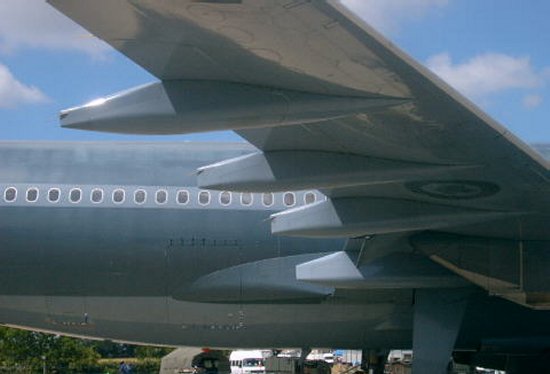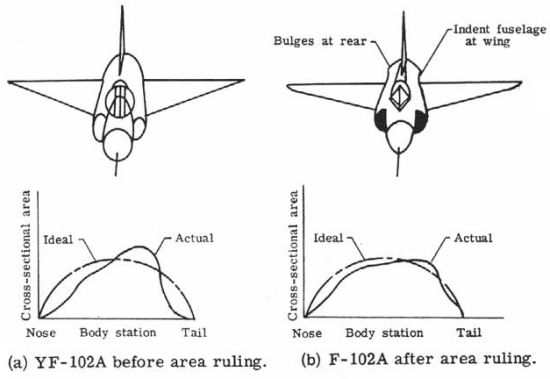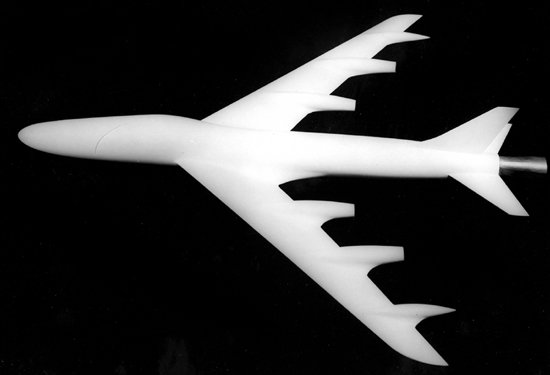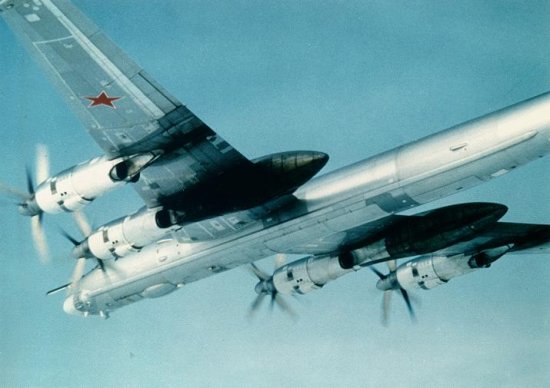|
||||||||||
|
|
||||||||||
|
||||||||||
|
|
||||||||||

The elongated shape of these fairings that extend beyond the trailing edge of the wing are due to an aerodynamic principal called the area rule described in a previous article. The area rule was discovered in the 1950s by NASA researcher Richard Whitcomb. Whitcomb had found that maintaining a smooth distribution in the cross-sectional area of an aircraft from nose to tail significantly reduces aerodynamic drag near Mach 1. This rule of thumb was successfully used to design a number of early supersonic fighters, most notably the F-102 Delta Dagger. The influence of the area rule can also be seen in other supersonic combat aircraft like the F-105 Thunderchief, F-106 Delta Dart, B-58 Hustler, F-4 Phantom II, and B-1B Lancer.

Even though the area rule is typically thought of only for supersonic flight, its principals are also applicable to planes traveling below the speed of sound. The area rule applies to any vehicle traveling at transonic speeds as low as approximately Mach 0.7. Most commercial airliners, including the A340, fly within the transonic region between Mach 0.8 and 0.85. The shape of the flap fairings used on these airliners helps bring the planes closer to the ideal cross-sectional area distribution of the area rule. The pods extend so far aft of the wing in order to maintain a smoother change in the area distribution along the length of the plane and reduce the overall drag.
Whitcomb began exploring applications of his area rule to subsonic commercial transports during the late 1950s. He quickly discovered that making relatively minor changes to the external shape could significantly reduce the drag these aircraft experience. Compared to the radical "waisted fuselage" shaping required for supersonic flight, subsonic aircraft could be made far more efficient simply by placing elongated pods along the wing trailing edge. Whitcomb referred to these pods as "antishock bodies" like those shown in the wind tunnel model pictured below. Also note the large bulge above the forward fuselage that Whitcomb found further improves transonic aerodynamics. This concept was later adopted for the Boeing 747.

The advantage of Whitcomb's wing pods can be appreciated by studying the following figure of a swept wing at Mach 0.9 both with and without the antishock bodies. These oil flow visualizations indicate the behavior of air as it passes over the wing. In the first image, a sharp break in the flow pattern is visible about halfway between the leading and trailing edges. This change in patterns indicates that the airflow over the aft portion of the wing has separated from its surface due to shock waves, resulting in high drag. The presence of antishock bodies, however, significantly reduces the strength of the shock waves and separated airflow is nearly eliminated. It is also interesting to note that Whitcomb later applied this same reasoning to the development of the supercritical airfoil during the 1970s.

Whitcomb's antishock body research was so promising that it suggested the economical cruising speed of a standard airliner could be increased from Mach 0.8 to as high as Mach 0.9. Convair soon put these findings into practice during the development of the CV-990 airliner. Although the competing Boeing 707 and Douglas DC-8 had already captured the bulk of the market, Convair hoped to attract customers interested in a higher cruise speed. Thanks to the addition of antishock bodies and other improvements inspired by the area rule, including modified engine nacelle and pylon shapes, Convair engineers were able to increase the economical cruise speed of the CV-990 to an impressive Mach 0.89.

Another pioneer of the area rule concept was German aerodynamicist Dr. Dietrich Küchemann. Küchemann had been a prominent supersonic researcher in Germany during the 1930s and 1940s. He later moved to the United Kingdom and joined the Royal Aircraft Establishment (RAE) after the war. Küchemann had spent considerable time studying how air flowed around bodies at supersonic speeds and had discovered his own form of the area rule. Küchemann had approached the issue from the perspective of trying to minimize spanwise flow rather than reducing drag, but his research led to the discovery of external shaping techniques very similar to those proposed by Whitcomb.
One of the concepts popularized by Küchemann was a pod located on the wing trailing edge comparable to Whitcomb's antishock body. These pods became an important factor in the design of Britain's Handley-Page Victor bomber since they significantly lowered the plane's drag and increased range. Due to their shape, these pods were often referred to as "Küchemann carrots."

Yet another aircraft that benefited from the research of Whitcomb and Küchemann was the Soviet Union's revolutionary Tu-95 bomber. The Tu-95 stunned Western observers when it demonstrated the ability to cruise at jet-like speeds of Mach 0.85 or more while using propeller-driven engines. One of the reasons for this aircraft's exceptional performance was the use of large engine fairings aft of the inboard engines. These pods brought the external shape of the Tu-95 closer to an ideal area ruled configuration to reduce drag and increase maximum speed.

The benefits of these external pods make it clear why they are so prevalent on commercial transports today. The
elongated shapes of flap track fairings obey the area rule so as to reduce the drag generated at transonic speeds.
The lower the drag, the less thrust is needed to fly at the same cruise speed. Reducing the required thrust means
that engines can be run at a more fuel efficient setting, and given the rising cost of oil, the plane becomes much
more economical to operate.
- answer by Jeff Scott, 7 August 2005
Read More Articles:


|
Aircraft | Design | Ask Us | Shop | Search |

|
|
| About Us | Contact Us | Copyright © 1997- | |||
|
|
|||